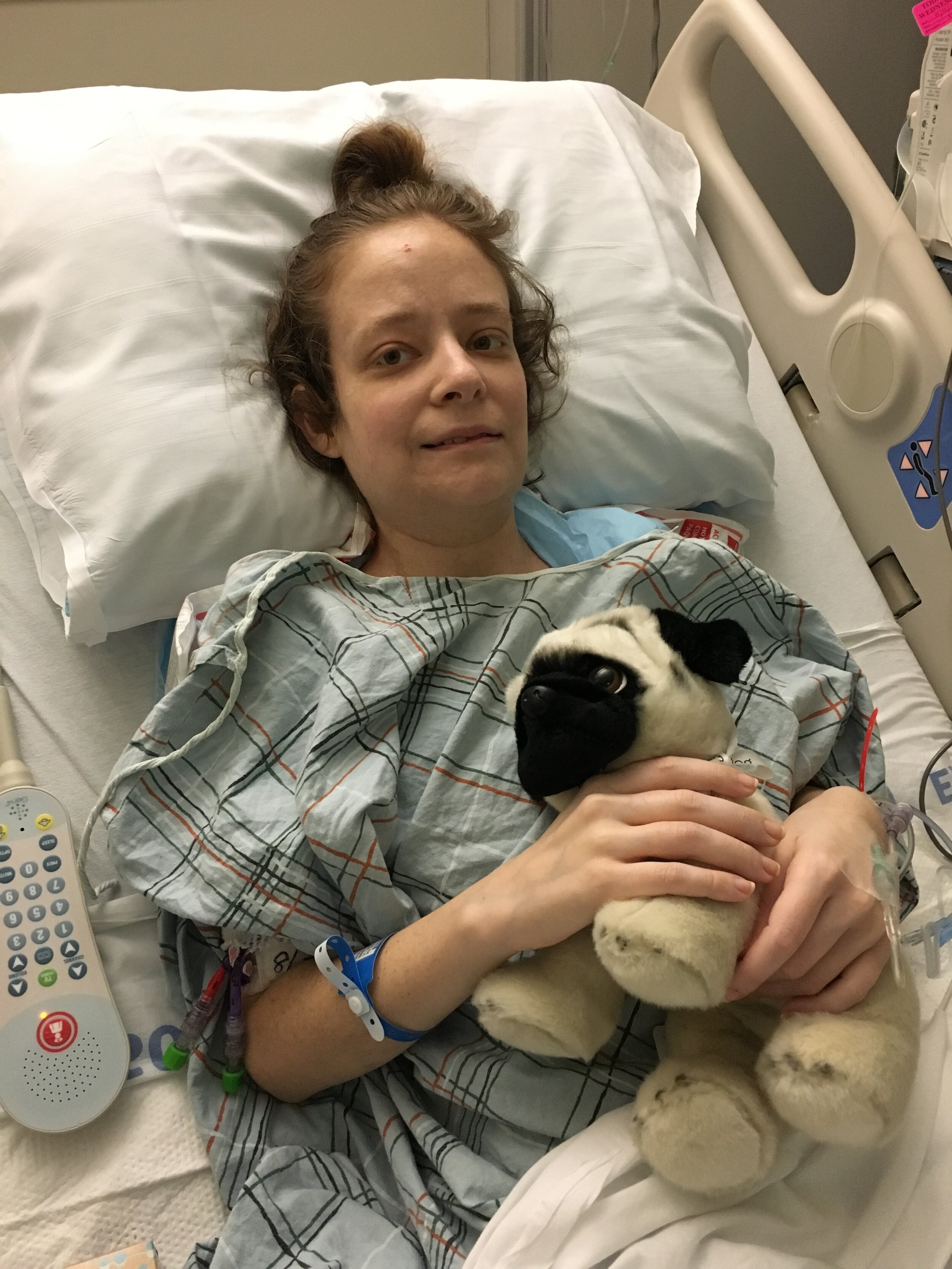IBD | Ostomy

The blogger sits in a hospital bed holding a stuffed pug.
A rush of excitement washed over me as I passed through the hospital’s big front doors onto the busy city sidewalk in my ‘civilian clothes.’ The August air was hot, humid, and filled with a cacophony of New York City smells. I had a long journey ahead of me, but I was finally free.
Following my discharge, the hospital set me up with home health care to learn how to care for my ostomy. My homecare nurse was extremely friendly and caring, but it quickly became apparent that she did not have much experience with ostomies. She told me to apply the wafer first, then roll the barrier ring into a snake and wrap it around the wafer on top of my stoma.
Those of you who have experience with ostomies are probably grinning and shaking your heads right now because you know how wrong this is. Even I thought it was strange at the time. I asked her why I couldn’t just place the preshaped barrier ring around my stoma. I mean, isn’t that why it is shaped like a ring?
After wrinkling her eyebrows in concentration, she shook her head and said that she was showing me the method she learned in class. I could tell my bag would not hold, but she reassured me it would be fine. I let go of my concern. I was only a patient, after all. Who was I to question a medical professional? What did I know?
I smiled and thanked her for her help. She would be back in three days for another change. Everything would be all right.
Within less than an hour of closing my front door, I began to feel a deep itch around my stoma. I shook my head, scolding myself for being so paranoid. Ten minutes later, the itch turned into a deep burn. Then, the smell came. I was not imagining things; my appliance was leaking.
I am not going to lie; I went into full-blown panic mode. I had only been out of the hospital for three days and had no idea what I was doing. I sat in my childhood bathroom with a towel and bowl catching my output while my mother called the home healthcare’s telephone service.
The man on the other end of the phone admitted to consulting his notes for my situation. He said that he did not think I needed a barrier ring with an ileostomy and that I should simply place the wafer and bag directly on my raw skin. In fact, he told me not to even let the wafer hug my stoma too tightly. He warned me that doing so could harm it.

Confusion and frustration washed over me like a tidal wave. The nurse at the hospital told me I needed to cut it to the right size. They even gave me two pairs of scissors to do so. They said I should always have them in my medical kit and even gave me a card in case I ever needed to explain them to security.
Now, this man was telling me that I could damage my stoma by cutting the wafer? The small hole in the wafers they gave me would not even fit around my stoma!! My mother and I tried to explain this to him. He said that the hospital must have given us the wrong supplies. We should cut the wafer to the largest size so that it would not touch the stoma.
After thanking the gentleman for all of his time and help, my mother and I went to the computer. Thankfully, many ostomates have made helpful instructional videos about changing bags. After watching a few of these, my mother and I were able to do a change that lasted two days by putting the barrier ring on first and cutting the wafer so that it fit snugly around my stoma.
As the weeks passed, I continued struggling with leaks that neither I nor my nurse could remedy. My sensitive skin was also extremely irritated not merely from leakage, but from the adhesive tape used to apply the ostomy.
The adhesive material made my skin break out in viciously red, itchy hives that would bleed and loosen the wafer’s grip. The home care nurse told me that this was “probably normal.” My skin would become used to the material over time. It would get “hard and coarse like feet,” she said.
I do not know why I placed so much trust in her after the incident with the barrier ring, but I did. After all, what else could I do? She was the one with a medical background, not me.
Instead of developing immunity, my skin grew worse. When I returned to the hospital for my postoperative follow-up, the wound care nurse was shocked by my skin. She gave me samples of various ostomy brands (who knew they had more than one brand?) and gave me a prescription powder and oral antibiotics to treat my skin.
I wish I could say that this was the end of my struggle with skin issues, but it was just the beginning. My second ileostomy posed even greater challenges and every professional seemed to have completely different contradictory advice.
After months of struggle, I gave up on anyone local and began heading into the city multiple times a week to see a wonderful skincare and ostomy nurse who helped me through the remainder of my ostomy journey. She struggled with my skin, wound, and troubled stoma, but she did not give up. She even advocated for my surgeon to do the reversal as soon as the pouch was fully healed and leak-free. She actually walked right into my surgeon’s office with me when I was going for a wound care procedure and insisted that she made room in her schedule.
I am fortunate that I found great care, but finding this care should not have taken months. It is exhausting to navigate a medical device that no one seems to know or care about. It is frustrating when professionals take a shot in the dark instead of admitting when they do not know the answer.
When the medical community and public are not aware of medical conditions or devices, the patients suffer. This is why I advocate for chronic illness warriors and ostomates.
